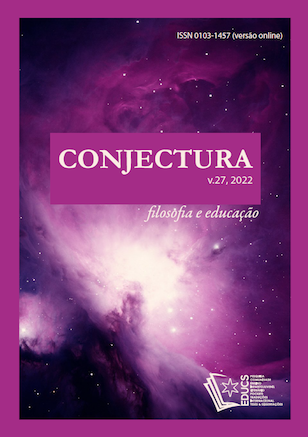Body cognitions: the sense of smell and the experience of flavor
DOI:
https://doi.org/10.18226/21784612.v27.e022037Keywords:
Odors, Retronasal Smell, Flavour Perception, Taste, Neurogastronomy, Anosmia, Ageusia.Abstract
For a long time considered one of the minor and weakest senses in human animals, smell actually plays a far from marginal function in our mode of existence in socio-emotional behaviors, in the evocation of memories and in non-verbal communication, and not least in our daily life especially for its role in the perception of food flavour. Thanks to the progress that research has achieved in recent decades, to the point of justifying among other things the birth of a new scientific enterprise known as neurogastronomy, the sense of smell, and in particular the retronasal smell, is even configured as one of our most species-specific abilities, to which we owe moreover, one of the greatest joys in life: the conscious pleasure of savoring and appreciating food and drink. Starting from this assumption, the aim of this essay is therefore to show to what extent an experience rooted in the body as the perception of flavour is attributable to the species-specific characteristics developed by the human sense of smell during evolution, configuring itself as a complex form of embodied cognition whose possibilities depend as much on the biological structure as on the actual use we make of this extraordinary bodily device.
Keywords: Odors, Retronasal Smell. Flavour Perception. Taste. Neurogastronomy. Anosmia. Ageusia.
References
Ackerman, D. Storia naturale dei sensi. (1990) trad. do it. Milano: Frassinelli, 1992.
Aristotele. Del senso e dei sensibili. (DSS). trad. do it. in Opere, vol. 4, Roma-Bari: Laterza, 1998, pp. 195-236.
Aristotele. Dell’anima. (DA) trad. do it. in Opere, vol. 4, Roma-Bari: Laterza, 1983, pp. 97-191.
Bensafi, M., Rouby, C. Cerveau et odorat. Comment (ré)éduquer son nez. Les Ulis: EDP Sciences, France, 2020.
Brillat-Savarin A. Fisiologia del gusto. (1825) trad. do it. in Lettura di Brillat-Savarin di Roland Barthes, pp. 1-273, Palermo: Sellerio, (ed. fr. 1975) 1978.
Broca, P. Recherches sur les centres olfactifs. Revue D’Anthropologie, 2, p. 385, 1879.
Buck L.B., Alex R. A novel multigene family may encode odorant receptors: a molecular basis for odor recognition. Cell, 65, pp. 175-187, 1991.
Bushdid, C., Magnasco, M.O., Vosshall, L.B., Keller, A. Humans can discriminate more than 1 trillion olfactory stimuli. Science, 343, pp. 1370–1372, 2014.
Cavalieri, R. Il naso intelligente. Che cosa ci dicono gli odori, Roma-Bari: Laterza, 2009.
Cavalieri, R. Gusto. L’intelligenza del palato, Roma-Bari: Laterza, 2011.
D’Errico, A. Il senso perfetto. Mai sottovalutare il naso, Torino: Codice Edizioni, 2019.
Harrison, S. Coronavirus: i pazienti che hanno perso l’olfatto, lo recupereranno? National Geographic, 20 agosto 2020.
Herz, R. Perché mangiamo quel che mangiamo. Il gusto spiegato dalla scienza (2018) trad. do it. Torino: EDT, 2020.
Horowitz, A. Una questione di naso. Essere un cane in un mondo di odori. (2016) trad. do it. Milano: Edizioni Sonda, 2018.
Kant I. Antropologia dal punto di vista pragmatico. (1798) trad. do it. in Scritti morali, Torino: UTET,
, pp. 535-757.
Kay, L. Why COVID-19 makes people lose their sense of smell. Scientific American, 13 june 2020.
Keller H. Il mondo in cui vivo. (1908) trad. do it. Milano: Fratelli Bocca Ed., 1944.
Lieberman, D.E. The evolution of human head, Cambridge (Mass): Harvard University Press, 2011.
Maresh, A., Rodriguez Gil, D., Whitman, M.C, Greer, C.A. Principles of glomerular organization in the human olfactory bulb – implications for odor precessing. PLoS One, July 9, 2008.
McGann, J. Poor human olfaction is a 19th-century myth. Science, vol. 156, 2017.
Niimura, Y., Matsui, A., Touhara, K. Extreme expansion of the olfactory receptor gene repertoire in african elephants and evolutionarydynamics of orthologous gene groups in 13 placental mammals. Genome Research, 24 (9), pp. 1485-1496, 2014.
Rolls, E. La corteccia prefrontale, l’area del sapore e della ricompensa. In AA.VV., Sensi diVini. Il segreto del cervello nella degustazione, Siena: Enoteca Italiana, pp. 35-43, 2003
Rolls, E. Taste, olfactory, and food processing in the brain, and the control of food intake. Physiology & Behavior, 85 (1), pp. 45-56, 2005.
Rozin, P. “Taste-smell confucions” and the duality of the olfactory sense. Perception and Psychophysics, 31 (4), pp. 397-401, 1982.
Shepherd, G.M. The human sense of smell: are we better than we think?. PLoS biology, 2 (5), 2004.
Shepherd, G.M. Smell images and the flavour system in the human brain. Nature, 444, pp. 316-321, 2006.
Shepherd G.M. All’origine del gusto. La nuova scienza della neurogastronomia. (2012) trad. do it. Torino: Codice Edizioni, 2014.
Shepherd, G.M. Neuroenology: how the brain creates the taste of wine. Flavour, 4, 2015.
Sutherland, S. Mysteries of COVID smell loss finally yield some answers. Scientific American, 18 nov. 2020.
Turner, W. The convolutions of the brain: a study in comparative anatomy. Journal of Anatomy, 25, pp. 105-153, 1890.
Wrangham, R.W. L’intelligenza del fuoco. L’invenzione della cottura e l’evoluzione dell’uomo. (2009) trad . do it. Torino: Bollati Boringhieri, 2011.
Wrangham, R.W., Jones, J.H., Laden, G., Pilbeam, D., Conklin-Brittain, N.L. The raw and the stolen: cooking and the ecology of human origins. Current Anthropology, 40, pp. 567-594, 1999.
Downloads
Published
How to Cite
Issue
Section
License
1. The publication of the originals will imply the assignment of copyright to Conjectura Journal.
2. Texts cannot be reproduced without authorization from the Journal after acceptance.









